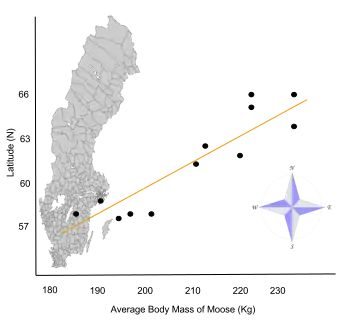Foster's rule
Foster's rule, also known as the island rule or the island effect, is an ecogeographical rule in evolutionary biology stating that members of a species get smaller or bigger depending on the resources available in the environment. For example, it is known that pygmy mammoths evolved from normal mammoths on small islands. Similar evolutionary paths have been observed in elephants, hippopotamuses, boas, sloths, deer (such as Key deer) and humans.[1][2] It is part of the more general phenomenon of island syndrome which describes the differences in morphology, ecology, physiology and behaviour of insular species compared to their continental counterparts.
.jpg.webp)
The rule was first formulated by van Valen in 1973[3][4] based on the study by mammalogist J. Bristol Foster in 1964.[5][6] In it, Foster compared 116 island species to their mainland varieties. Foster proposed that certain island creatures evolved larger body size (insular gigantism) while others became smaller (insular dwarfism). Foster proposed the simple explanation that smaller creatures get larger when predation pressure is relaxed because of the absence of some of the predators of the mainland, and larger creatures become smaller when food resources are limited because of land area constraints.[7]
The idea was expanded upon in The Theory of Island Biogeography, by Robert MacArthur and Edward O. Wilson. In 1978, Ted J. Case published a longer paper on the topic in the journal Ecology.[8]
Recent literature has also applied the island rule to plants.[9]
There are some cases that do not neatly fit the rule; for example, artiodactyls have on several islands evolved into both dwarf and giant forms.[10][11]
The Island Rule is a contested topic in evolutionary biology. Some argue that, since body size is a trait that is affected by multiple factors, and not just by organisms moving to an island, genetic variations across all populations could also cause the body mass differences between mainland and island populations.[12]
References
- Juan Luis Arsuaga, Andy Klatt, The Neanderthal's Necklace: In Search of the First Thinkers, Thunder's Mouth Press, 2004, ISBN 1-56858-303-6, ISBN 978-1-56858-303-7, p. 199.
- Jean-Baptiste de Panafieu, Patrick Gries, Evolution, Seven Stories Press, 2007, ISBN 1-58322-784-9, ISBN 978-1-58322-784-8, p 42.
- Van Valen, L. (1973). "Body Size and Numbers of Plants and Animals". Evolution. 27 (1): 27–35. doi:10.2307/2407116. JSTOR 2407116. PMID 28563673.
- Lokatis, S.; Jeschke, J.M. (2018). "The island rule: An assessment of biases and research trends". Journal of Biogeography. 45 (2): 289–303. doi:10.1111/jbi.13160.
- Foster, J.B. (1964). "The evolution of mammals on islands". Nature. 202 (4929): 234–235. Bibcode:1964Natur.202..234F. doi:10.1038/202234a0. S2CID 7870628.
- Foster, J. B. (1965) The evolution of the mammals of the Queen Charlotte Islands, British Columbia. Occasional Papers of the British Columbia Provincial Museum, 14, 1–130.
- Whittaker, R.J. (1998). Island biogeography: ecology, evolution, and conservation. Oxford University Press, UK. pp. 73–75. ISBN 978-0-19-850020-9.
- Case, T.J. (1978). "A general explanation for insular body size trends in terrestrial vertebrates". Ecology. 59 (1): 1–18. doi:10.2307/1936628. JSTOR 1936628.
- Biddick, M.; Hendriks, A.; Burns, K.C. (2019-08-19). "Plants obey (and disobey) the island rule". Proceedings of the National Academy of Sciences. 116 (36): 17632–34. Bibcode:2019PNAS..11617632B. doi:10.1073/pnas.1907424116. PMC 6731657. PMID 31427521.
- Mazza, P.P.A.; Rossi, M.A.; Agostini, S. (2015). "Hoplitomerycidæ (Late Miocene, Italy), an Example of Giantism in Insular Ruminants". Journal of Mammalian Evolution. 22 (2): 271–77. doi:10.1007/s10914-014-9277-2. S2CID 16437411.
- van der Geer, A.A.E. (2018). "Uniformity in variety: Antler morphology and evolution in a predator-free environment". Palaeontologia Electronica (21.1.9A): 1–31. doi:10.26879/834.
- Lokatis, Sophie; Jeschke, Jonathan M. (2018). "The island rule: An assessment of biases and research trends". Journal of Biogeography. 45 (2): 289–303. doi:10.1111/jbi.13160.
External links
- "Why Do Islands Breed Giants (And Sometimes Dwarfs)?", episode of PBS's Nova
